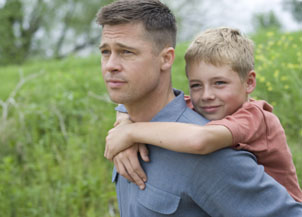|
|
Movie Review: The Tree of LifeBy Matthew HuntleyJune 6, 2011
The way I’ve described the story might suggest this is a star vehicle for Brad Pitt and Sean Penn, but in actuality their scenes only make up a fraction of The Tree of Life. Malick intercuts their stories with elusive, episodic scenes from Jack’s childhood, circa 1960s, in a small suburban neighborhood. As a boy, Jack (Hunter McCracken) often resorted to violence and aggression in response to his strict and overbearing father. These scenes do not unfold in the usual linear fashion but play more like memories and dreams, the kind our minds filter both consciously and subconsciously as we attempt to recollect and make sense of them. Complementing the human coming-of-age tale are images of the greater universe and developing world, which should come as no surprise since Malick is a director who loves the rawness and beauty of nature. They reminded me, as they will no doubt remind many, of Stanley Kubrick’s 2001: A Space Odyssey, as we observe the changing cosmos without the influence of man. From the sun rising, to a volcano erupting, to the ocean’s waves crashing, to the planets converging, we see how the dynamics of a typical family unit exist elsewhere in the universe’s other relationships, be they living or inanimate. Perhaps Malick wants us to see that all relationships are cyclical and have more or less remained constant for millions of years, as far back as the dinosaur era. He shows us these images over and over again, sometimes to the point of exhaustion.
|

|
|
|

|
Friday, April 19, 2024
© 2024 Box Office Prophets, a division of One Of Us, Inc.


